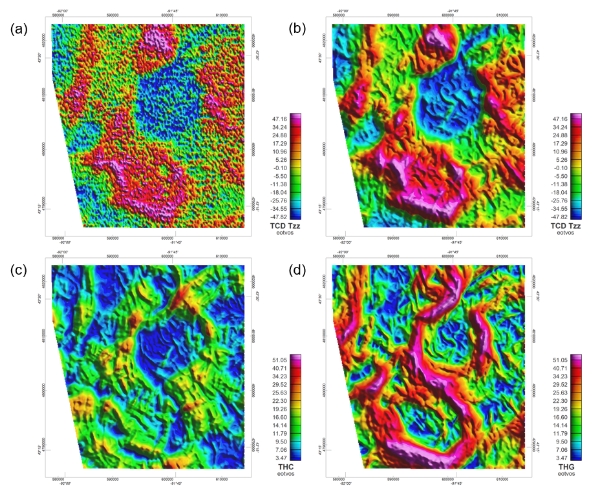Retrieving geological signal from full tensor gravity gradiometry data using source body migration
Authors : Colm Murphy*, Richard Farnell, Chris Bellamy and Alan Morgan, Bell Geospace.
Objectives
Geological interpretation from full tensor gravity gradiometry (FTG) depends on the successful retrieval of signature patterns arising from geological structure and contact lineaments in the sub-surface. However, challenges in the form of depth uncertainty and the presence in final processed data of a noisy anomalous overprint described by a high frequency, low amplitude anomaly caricature arising from the overburden often prevail; leading to less than desired interpretations. In this paper, we describe a process to overcome this challenge. A source body migration workflow is used to identify depth sensitivity of dominant signal and a self-steering directional filter is used to extract clear signal associated with geology.
Methods and Procedure
Source Body Migration (SBM), described by Brewster & Murphy (2020), is a fast, robust, unconstrained inversion method that identifies depth sensitivity producing meaningful depth interval anomaly fields from FTG data. SBM transforms the final processed tensor data to a 3D density field for a mass distribution of point sources at the as-flown altitude. Forward models are then automatically calculated from the density distribution and evaluated for estimated relative, mean depth sensitivities. Maximum and minimum depth sensitivity is identified and used to construct a set of depth interval anomaly maps. Nominated parameters include top of model, maximum depth / base of model, and voxel size.
The final output is differenced against the starting input data resulting with a signal pattern dominated by a high frequency, low amplitude pattern that typifies the caricature of final processed gravity gradient data. SBM facilitates direct extraction of highly coherent geological signal.
The self-steering directional filter (SSDF) is described by Brewster et al, 2014. Using the full suite of tensor components, it works by first identifying strike lineaments of different orientations associated with elongate anomaly patterns. The filter is designed to incrementally extract source anomaly for the strike directions. The method works first on long linear strike lengths before iteratively adding increasingly shorter strike lengths.
The SSDF is applied to SBM anomaly data identifying high confidence anomaly patterns allowing careful separation of signal arising from geology for different depth intervals.
Observations
FTG data acquired over the Midcontinent Rift System in NE Iowa for the USGS (data available from https://mrdata.usgs.gov/) contains shallow sourced signal characterized by a dominant high frequency, low amplitude signal preventing confident interpretation of the more subtle deeply sourced geological signal. The data is selected for the work to improve the geological signature response.
Figure 1 (a) shows the delivered terrain corrected Tzz and (b) the corresponding Tzz output from SBM. The improvement in signal coherency is noted with the SBM output. The lower panel shows outputs from SBM for (c) the total horizontal curvature THC generated by combining Txx, Txy and Tyy and (d) the total horizontal gradient THG by combining Txz and Tyz.

Figure 1 NE Iowa FTG. (a) original final processed and terrain corrected tzz. (b) SBM corrected Tzz. (c) SBM corrected Total Horizontal Curvature. (d) SBM terrain correted Total Horizontal Gradient.
SBM identifies FTG depth sensitivity to be greatest from 250m to 700m below ground where the signal intensity is greatest. A deeper interval showing sensitivity at near 1,800m below ground describes the regional setting. The SBM outputs for (b) Tzz, (c) THC and (d) THG show a step up in signal coherency.
The large negative anomaly depicted in Tzz is associated with a felsic granitic pluton set in higher density country rocks of the Decorah and NE Iowa Igneous complexes (Drenth et al, 2015). SSDF is next applied to extract the anomalous patterns associated with structures and contact lineaments from the SBM depth information. Linear trends locate geological contacts. They show a prevalence for NNE and WNW contacts. Moreover, a subtle NNW and ENE trend is also evident, something not visible in the original processing. Structural complexity is best mapped from the THC where warm coloured anomalies are associated with geological structure that shows curvature.
Significance
SBM shows clear ability to extract high confidence, high quality signal from final processed gravity gradient data. The added benefit of determining depth sensitivity directly from the data facilitates a direct means of separating signature patterns into depth intervals; allowing a more efficient interpretation of target geology. This is of increasing relevance when exploring for mineral deposits or pursuing energy transition activity in areas where the targeted depths are overlain by variable thickness sedimentary cover, and the need to retrieve high coherency, high quality signal is imperative.


.jpg)
